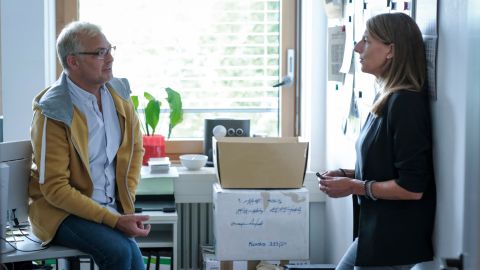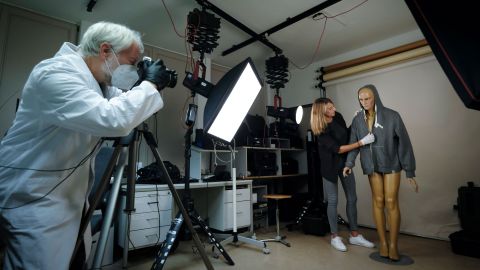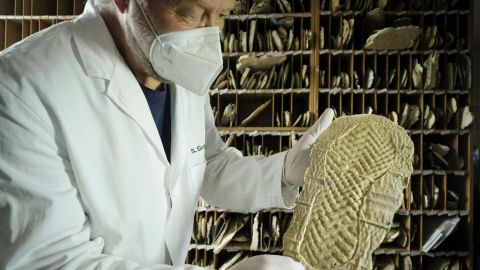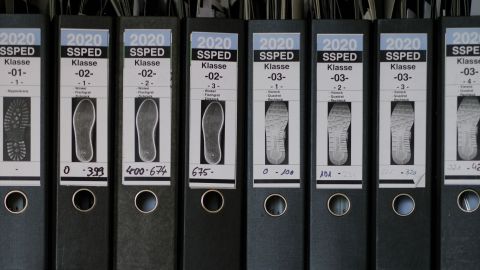When the chief inspector took over MK "Howe" at the beginning of the week, the main victim's life was still in danger. They are investigating attempted murder. The starting point was a drug deal in Tecklenburg in the district of Steinfurt, which, like the districts of Warendorf, Coesfeld and Borken, falls under the jurisdiction of KK11.
Two young men from the small town near the Teutoburg Forest wanted to buy marijuana from two barely older dealers from Lengerich. They met in the courtyard of the secondary and comprehensive school. Apparently, the buyers had the intention of "ripping off" the sellers and disappearing with the substance. The two drug dealers wanted to prevent this, Böhlendorf describes the events. One of the dealers then pulled out a knife and seriously injured the 20-year-old. He was stabbed in the spleen, lungs and intestines. The 17-year-old friend escaped with minor injuries. "Unfortunately, the inhibition threshold for using a knife as a weapon has fallen very low," the policewoman notes.
At first, the two victims kept quiet about the perpetrators because they didn't want to incriminate themselves because of the BTM deal, she says. However, someone close to them then called the police and provided information. "So we were able to arrest the wanted men in the early hours of this morning. One at home, the other on his way to work." One of them has even testified and admitted his involvement, she reports.
"When you make an arrest, you have to think carefully about where you want to go," explains Böhlendorf. "Our self-protection has top priority." The tactical concept must be carefully considered. Nobody should come to any harm. "Sometimes we lure a suspect out of an apartment. Or we obtain the layout of the premises from the land registry or the building authority so that we can operate in a targeted manner." The mobile task force (MEK) or the special task force (SEK) are also sometimes called in to help with people who have been classified as particularly dangerous. "Today we were able to work with our own forces. Everything went smoothly."
The detective has already led several homicide commissions at Münster police headquarters. "I look forward to work every morning," she admits. "But working in a KK11 is special and not everyone's cup of tea."
Of course, you take the work home with you in your mind. The TV crime dramas portrayed this quite accurately. "You can't let go of the cases," says the Hamburg native matter-of-factly. "But it motivates me not to know what the day will bring when I get up." According to the 48-year-old, the scientific side of the job in collaboration with the forensic scientists and the Forensic Technical Investigation Unit (KTU) is also fascinating.
In the past, solving homicides was considered the supreme discipline for the police. There were far more applicants than jobs. Today, the capital crime squads are struggling to find new recruits. They not only investigate homicides, but also other serious crimes. The intensity of the work, the time pressure and the many on-call duties put a strain on KK11 in Münster as elsewhere.
It is normal to receive a call at night in the event of a homicide and then drive to the crime scene or the police station to initiate the necessary steps, Julika Böhlendorf explains. "You also quickly grab a coffee in a paper cup and stain your T-shirt before you arrive. Sometimes life is just like in the movies."
If there are signs of an unnatural death, the first step is to inform the public prosecutor's office or the local court. "The cause and circumstances of the death must be clarified as quickly as possible at the scene and in the forensic department." In Münster, a corpse to be autopsied is driven to the institute of the university hospital.
In addition to two doctors and an assistant, a public prosecutor, a homicide investigator and possibly a member of staff from the KTU are also present in the autopsy room. But nobody swaggers around like film professor Börne in the "Tatort" crime thriller. The head of forensic medicine, played by Jan Josef Liefers, always interferes in the investigation.
"It's fictitious, of course," says the policewoman. In reality, everyone is very focused on their actual task, she knows from her own experience. "The internal post-mortem examination is a very important part of our work," she emphasizes. "The examination often provides crucial clues about the crime and the perpetrator."
However, the tone in the autopsy room can sometimes be flippant. "The whole thing can take hours. In the meantime, we discuss the findings," says the mother of two adult children. "Later, we receive a detailed written report from the coroner. The preliminary findings come by phone."
The investigative work has many facets. The first thing Julika Böhlendorf shows us is the room where the interviews are recorded and the statements of the accused are captured on camera from different perspectives. "This gives the court a good impression of whether the statements appear credible." In this way, it is possible to assess whether the interviewee was nervous, dazed or composed. "Unfortunately, a lawyer is now usually called in immediately and advised not to comment on the case."
The bloodstained clothing of the seriously injured victim from Tecklenburg hangs in the drying room, a former cell. Stefan Eierhoff from the KTU then leads us into a neighboring room. There, the chief inspector throws a jacket over a mannequin as a demonstration. "The defects left on the clothing by a knife or a gunshot are very revealing," he states. "The damage to the textiles allows us to draw conclusions about the execution of the crime. We also record this photographically."
Forensic evidence often provides the crucial pieces of the puzzle. This includes DNA analysis, but also microfiber traces that an attacker leaves behind on the victim, for example with their sweater.
In a chamber, shoe imprint traces are collected from shoe soles at crime scenes. "A small crack in the tread makes it possible to identify someone wearing Nike sneakers," says Eierhoff. "Even if there are millions of copies of such a model." Finally, he points to a device that develops fingerprints in a "moist environment". "We used to use carbon black powder. This easily led to soiling. Today's process, on the other hand, guarantees a contact-free seizure."
Back at KK11, we are greeted by head Joachim Poll. The First Chief Superintendent only took over the police station in May, where he has worked for over 25 years. He handles the cases with 14 colleagues. "This is only possible because everyone is so committed," says the experienced investigator. For the homicide commissions, it is important to take the right direction and form good teams to complete the various tasks. Witnesses have to be heard, personal details investigated, suspects monitored and data secured on the network. "If we couldn't rely on employees from other departments, we wouldn't be able to do it," says the 57-year-old from Münster.
There have been enough memorable cases in the recent past. Poll himself solved a particularly spectacular murder in 2019 as head of MK "Brunnen". In July of that year, the body of a 79-year-old woman was found in the fountain of a nursery that belonged to her in Neuenkirchen, Münsterland. The autopsy revealed that the woman had drowned. A hematoma on her head could have been caused by a fall, but could also have been caused by an external factor. The son who was arrested initially had to be released due to a lack of urgent suspicion.
"Over the next few weeks, however, the evidence grew stronger," says Poll. The investigators discovered that the 54-year-old had fallen out with his mother. She wanted to sell the nursery the following day. The son feared being disinherited. He was arrested in October 2019. It was conclusively proven in court that he had knocked the old woman unconscious in her house and sunk her in the well with a belt. The master gardener, who denied the crime to the end, was sentenced to life imprisonment by the jury chamber at Münster District Court in February 2021. "It takes a lot of hard work to ensure that the indictment in a circumstantial trial is watertight," Joachim Poll makes clear. "The cooperation between our KK11 and the public prosecutor's office is excellent."
At the beginning of August 2019, the disappearance of a 68-year-old woman from Münster caused headaches. The body was found a few weeks later on an embankment in Schleswig-Holstein with strangulation marks on her neck. "We quickly suspected the nephew living near Pinneberg, who admitted to our investigators that he had visited her aunt during the time of the crime." The homicide squad came across a loan agreement for 25,000 euros. The business IT specialist had concluded this with his relative. She apparently wanted the money back.
"We also found a DIY store invoice for a tarpaulin, cable ties and a ship's rope that the fake doctor, a notorious liar, had bought three days before the crime," Poll recalls. Phone data and chat logs further incriminated the defendant, who maintained his innocence before the Münster Regional Court. In July 2020, the man who had led a double life also received a life sentence.
The murder of a 34-year-old Aramaic Christian in Ahlen, who was shot in the head and one in the leg at close range in the driveway of his home on December 10, 2020, is still a mystery. 55,000 was offered to catch the perpetrator - 50,000 from the family and 5,000 from the public prosecutor's office. "The cook had come home from work and stopped at a snack bar. Then he drove home," says Julika Böhlendorf, describing the immediate background to the murder, which she is also working on as the head of the MK. "We have two projectiles. Otherwise, we're still pretty much in the dark." She plans to present the "cold case" on ZDF's "Aktenzeichen XY ... ungelöst" soon.
Julika Böhlendorf has been at KK11 since 2017. The passionate sportswoman and motorcyclist started out as a patrol officer. She then worked as a bodyguard for a long time before switching to the residential burglary investigation unit. "Now I want to stay here."
We make our way to the forensics department. It's important to have seen this place once, she says. The compartments with the corpses, the functional coolness of the tiled autopsy room and even the special smell don't put her off. Dealing with death is part of her job. "I'm here about once a week."
It's important to maintain a professional distance from the investigative processes. This usually works.
"Sometimes it's difficult," she says thoughtfully. Especially when very young people are involved. "Once a girl was killed who was the same age as my son. She also lived very close by. Something like that affects me more than normal."





